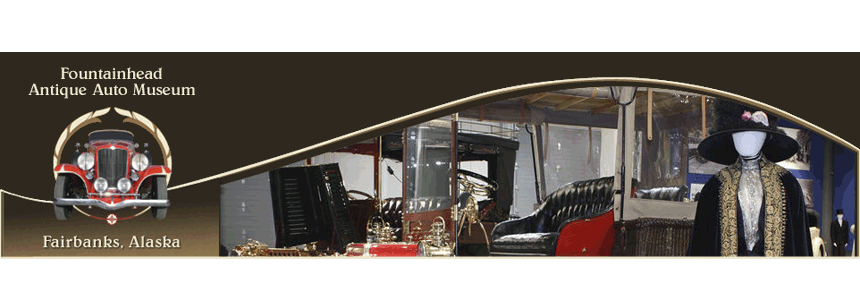 by Nancy DeWitt
by Nancy DeWitt
© Fountainhead Antique Auto Museum
Temperatures dipped to -40 F in Fairbanks this week, but historic fashion curator Barbara Cerny has been busy heating up the museum with some hot new acquisitions. She recently found some amazing pieces to add to our collection, including another Fortuny gown, a Molyneaux flapper dress and a Gallenga tabard.
Our European couture selection also includes this lovely Callot Soeurs dress (ca. 1898-1904), which Barb put on display this fall. Sisters Marie Callot Gerber, Marthe Callot Bertrand, Régine Callot Tennyson-Chantrelle and Joséphine Callot Crimont launched their fashion careers with a shop that sold antique laces, ribbons and lingerie. In 1895 they established a couture house on Rue Taitbout in Paris. By the turn of the century they employed 600 workers and soon attracted clients from throughout Europe and America.
Temperatures dipped to -40 F in Fairbanks this week, but historic fashion curator Barbara Cerny has been busy heating up the museum with some hot new acquisitions. She recently found some amazing pieces to add to our collection, including another Fortuny gown, a Molyneaux flapper dress and a Gallenga tabard.
Our European couture selection also includes this lovely Callot Soeurs dress (ca. 1898-1904), which Barb put on display this fall. Sisters Marie Callot Gerber, Marthe Callot Bertrand, Régine Callot Tennyson-Chantrelle and Joséphine Callot Crimont launched their fashion careers with a shop that sold antique laces, ribbons and lingerie. In 1895 they established a couture house on Rue Taitbout in Paris. By the turn of the century they employed 600 workers and soon attracted clients from throughout Europe and America.

Marie was the chief designer and by the 1920s was called "the backbone of the fashion world of Europe." The sisters were renown for their extraordinary technique that combined exquisite fabrics like silk, satin, brocade and gold lamé with antique lace, lavish beading and intricate embroidery. More examples of their dresses and gowns can be seen here.
This trained evening gown has an underskirt made from taffeta-like silk overlain with a delicate layer of silk gauze and lace-adorned tulle. The laces forming the chain-like pattern and the skirt's border are made up of exquisite floral designs. Other delicate laces adorn the bodice and sleeves. You really need to see this gown in person to appreciate its detail and craftsmanship.
 Madeline Vionnet, one of the 20th century's great designers, apprenticed at the House of Callot Soeurs. She later said. "Without the example of the Callot Soeurs, I would have continued to make Fords. It is because of them that I have been able to make Rolls-Royces."
Madeline Vionnet, one of the 20th century's great designers, apprenticed at the House of Callot Soeurs. She later said. "Without the example of the Callot Soeurs, I would have continued to make Fords. It is because of them that I have been able to make Rolls-Royces."We will be offering a series of curator's tours of our fashion collection this winter, starting with an introductory tour titled "Fashion Through the Decades" on Sunday, December 9. Museum historian Nancy DeWitt will showcase how fashions changed dramatically from the 1880s through the 1930s. The tour starts at 1 and is free with museum admission. Beginning in January, we will offer more in-depth tours that focus on specific fashion eras and the techniques and materials of individual garments in our collection.

No comments:
Post a Comment
Blogging about the Fountainhead Antique Auto Museum's latest news, adventures and research